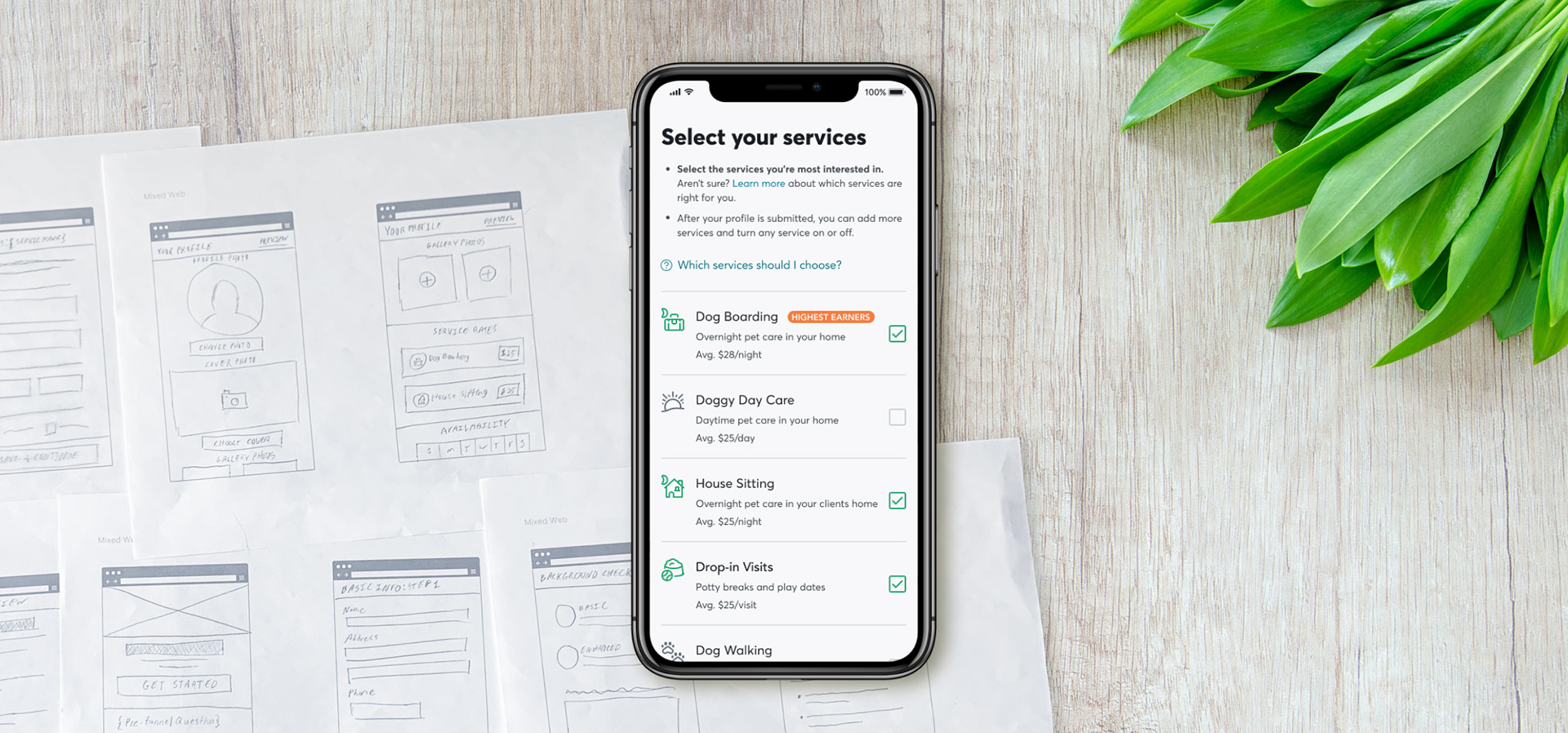
01. Overview
The sitter sign up funnel is a core experience of Rover and is the primary driver for getting prospective providers to be listed on the platform.
The Challenge
The existing funnel had been tweaked and modified with new additions over the years, but with no real optimizations to usability or scalability. Funnel metrics were showing many inefficiencies and pain points, especially for mobile users. We felt it was time to revisit the funnel and design a more modern, extensible, and user-friendly experience.
Dimensions of success included:
1️⃣ Creating a more user-friendly intake process for onboarding new sitters
2️⃣ Increasing quality and matriculation (providers with 3+ bookings) of sitters
3️⃣ Creating a flexible funnel to allow for targeting based on market needs
4️⃣ Decreasing the time it takes for a user to complete sign up and provide a service
5️⃣ Decreasing CX support costs
6️⃣ Engineering extensibility
My Role
I was the lead Product Design er and worked closely with my Product Manager partner to ideate and deliver on a solution that, first and foremost, was empathetic to our users' goals. We needed to balance user needs with the business goals of supplying markets with quality sitters.
RESEARCH & INSIGHTS
I worked closely with a User Researcher to gather insights and identify pain points on the existing experience. We conducted in-person usability studies with 8 participants that were new to Rover and had an expressed interest in becoming Rover sitters. We also used data analytics to identify where funnel drop-off was occurring.
VISION & STRATEGY
I started with high-level concepts that I felt could solve some of the problems identified in the research phase. I presented these concepts to other design team members as well as my product partners to help narrow in on an ideal solution.
EXPERIENCE & INTERFACE DESIGN
Taking a mobile first approach, I created user flows, wireframes, prototypes, high-fidelity mocks, and design specs. I worked closely with engineers to ensure designs were in scope with the level engineering effort allocated to the project.
VALIDATION & ITERATION
Using clickable prototypes, I tested concepts with available user testing toolkits. I tested the end-to-end experience, as well as conducted more focused testing to validate specific ideas and UI controls.
02. Design Process
The first step was to conduct user studies of the existing sitter sign up funnel to identify pain points. I worked closely with a user researcher to write a test plan and observe user behaviors. Based off user research analysis, data analytics, and business metric goals, I began to roughly conceptualize possible solutions.
After reviewing and receiving feedback on high-level concepts with other design team members, product partners, and engineers, I narrowed down to a single solution that we felt would meet the desired success metrics and was feasible in scope for the amount of engineering effort that was allocated.
The next step involved moving concepts into a wireframe/mid-fidelity state and building a prototype where we could begin validating assumptions with user testing. Based off of the findings, I iterated on the solutions where the experience was not meeting expectations.
03. research & Insights
Using the existing sign up funnel, we conducted in-person user tests with 8 participants that were new to Rover and had an expressed interest in becoming Rover sitters.
Key takeaways:
🤨 The overall flow and funnel structure causes users to feel overwhelmed, disoriented, and blocked.
🤔 Potential sitters lack a firm understanding of how Rover works. They need a lot more context around services, rates, and their related preferences.
🕵️♀️ Participants also had an appetite for more informational content to better explain how things work and what it takes to be a successful pet sitter.
Example screens from the legacy sign up funnel
04. IDEATION
"How might we create an experience that will set potential pet sitters up for success?"
Armed with the knowledge gathered from our research and user testing, I set aside time to sketch out some concepts to build a new experience for the sign up funnel. After presenting these ideas to the broader design team and other stakeholders, we narrowed down to a concept that was considered feasible and in-scope, but also addressed many of the problems we identified.
Potential concepts
💡 Sitter Personas
Provide a pre-defined set of profiles that align to the most common lifestyles of our providers. This would allow for a quick-start means of creating a profile.
Provide a pre-defined set of profiles that align to the most common lifestyles of our providers. This would allow for a quick-start means of creating a profile.
💡 Social Profiles
Connect social media accounts to quickly build profiles with already existing information.
Connect social media accounts to quickly build profiles with already existing information.
💡 Intent Questionnaire
Ask a series of questions top-of-funnel whose answers would be used to recommend services as well as profile defaults.
Ask a series of questions top-of-funnel whose answers would be used to recommend services as well as profile defaults.
💡 Single Service Sign Up
To expedite the process, as well as to ensure market supply, only require users to complete preferences for one service at sign up.
To expedite the process, as well as to ensure market supply, only require users to complete preferences for one service at sign up.
Artifacts from brainstorm and ideation sessions
The winning concept
We decided to move forward with a combination of the Intent Questionnaire + Single Service Sign Up. We felt these concepts best met our goals and were within scope of development estimates. We decided to couple this approach with a non-linear funnel to allow for more user control.
Concept sketches
05. validating Assumptions
Building off the concept sketches, I created wireframes, user flows, and prototypes to provide better visual communication of our intent to stakeholders.
Wireframes
Wireframes were created to explore visual direction and hierarchy of information.
Prototype
In order to validate assumptions, I created a high-fidelity prototype on which to run user tests. We conducted tests with 10 participants from middle to upper middle class economic brackets, as they represented the largest segment of our user base. All participants had never used Rover before.
Questions we were seeking answers to included:
𝐐. Are intent questions helpful? Will prospective sitters want to be recommended a service to provide?
𝐐. Are we correctly setting expectations around what is required to complete the process?
𝐐. Do users clearly comprehend the options presented to them? Are they utilizing help links?
𝐐. Did we significantly reduce the time to completion from the legacy funnel?
⇣ Live prototype. Go ahead and interact with it! ⇣
Test results
8 of 10 participants appreciated the intent questions, but they felt they would rather be able to choose their own services.
10 of 10 participants liked being able to jump to any module in the funnel, but most participants stated they would likely complete them in the order presented.
6 of 10 understood the reasoning behind only requiring completing a single service to start, but still expressed desire to see other available services.
9 of 10 were extremely appreciative of the example profiles within the profile module and felt they would be useful in helping them craft their own successful profile.
"This was easy to use. It feels familiar to other apps I've used, which I appreciate."
- User Testing Participant
"The design feels friendly. I know exactly what I need to do to complete my profile."
- User Testing Participant
06. Execution
Based off learnings from our user tests, we made some concessions to the idealized solution. We didn't have enough confidence in the validity of the intent questions, and thus opted to provide a service selector so that potential sitters could choose which services they wanted to provide.
Key differences between legacy and the new sign up funnel:
Deliverables
To bring the project to life required constant communication with the engineering team to ensure specifications were being adhered to. Deliverables included functional specs for each module, user flows, interaction details, and component states.
Example user flows and specs used to communicate design and interaction intentions
Final screens
Below are examples of what was delivered and executed on for phase 1 of our launch.
07. What we learned
The new sitter sign up funnel was launched with several hypotheses and risks in mind. We initially launched to a limited number of US markets in order to test, validate, and iterate. We closely monitored the data through Periscope dashboards and FullStory user observations.
HYPOTHESES
🔬By only requiring completing one service module at sign up, we will decrease the time it takes to sign up, and thus increase throughput.
🔬Improved usability will increase the conversion rate.
🔬By removing all non-required inputs, we'll dramatically reduce the time-to-completion.
🔬Exposing all steps from the start will unblock users from continuing when they don't have the required information ready.
RISKS
⚠️ Users will not want to be forced into a single service.
⚠️ Users will not set non-required preferences post- submit.
⚠️ Users will not add more services post-submit.
⚠️ Users will not change defaults post-submit.
Results
After launching, we started to observe several interesting trends, including:
Overall funnel completion rate went down
We believe this is due to only showing a single service on the hub. Users tried to back out of the funnel to choose a different service. Users were also not comprehending visual indicators of funnel completion.
We believe this is due to only showing a single service on the hub. Users tried to back out of the funnel to choose a different service. Users were also not comprehending visual indicators of funnel completion.
We saw a significant increase in quality profiles being submitted
We believe this was because we provided helpful in-context tooltips and eased the requirements needed to submit a profile.
We believe this was because we provided helpful in-context tooltips and eased the requirements needed to submit a profile.
Average time-to-completion was reduced by nearly 50%
Fewer required inputs and a more clean and friendly design helped users get through the funnel quicker.
Fewer required inputs and a more clean and friendly design helped users get through the funnel quicker.
In-context help tooltips were used often
We could look at which tooltips were being used the most and use that data to make optimizations to those sections of the funnel.
We could look at which tooltips were being used the most and use that data to make optimizations to those sections of the funnel.
fast follows
We quickly reacted to the data to iterate and plan quick follow up tests. These included:
• Allowing users to setup all their selected services at once
• Creating better progression indicators on the hub
• Adding additional value props to under-supplied services
• Allowing users to choose the pet type (dog or cat) that they want to provide services for
